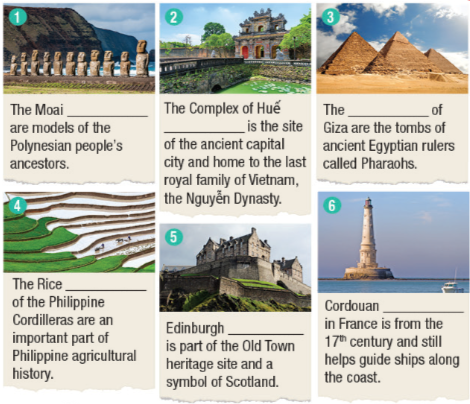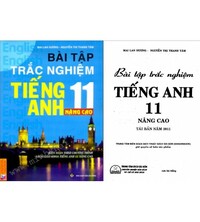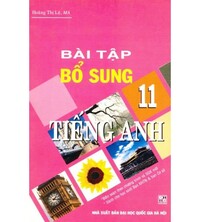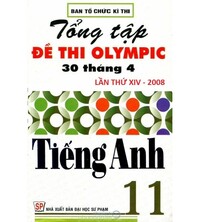Tiếng Anh 11 Bright Unit 4 Introduction
1. Fill in each gap with Lighthouse, Monuments, Statues, Castle, Pyramids or Terraces. Then listen and check. 2. Which World Heritage Sites in Exercise 1 do you find the most impressive? Why? Tell your partner. 3. Listen to the sentences. Underline the words with an /ʊ/ sound and circle the words with an /u:/ sound. Then listen again and repeat. Practise saying them with a partner. 4. Listen to three friends talking about preserving World Heritage Sites. Answer the questions. Write the answers i
Bài 1
1. Fill in each gap with Lighthouse, Monuments, Statues, Castle, Pyramids or Terraces. Then listen and check.
(Điền vào từng khoảng trống với Ngọn hải đăng, Di tích, Tượng, Lâu đài, Kim tự tháp hoặc Ruộng bậc thang. Sau đó nghe và kiểm tra.)

Phương pháp giải:
- Lighthouse: ngọn hải đăng
- Monuments: di tích
- Statues: tượng
- Castle: lâu đài
- Pyramids: kim tự tháp
- Terraces: ruộng bậc thang
Lời giải chi tiết:
|
1. Statues |
2. Monuments |
3. Pyramids |
|
4. Terraces |
5. Castle |
6. Lighthouse |
1. The Moai Statues are models of the Polynesian people's ancestors.
(Tượng Moai là hình mẫu của tổ tiên người Polynesia.)
2. The Complex of Huế Monuments is the site of the ancient capital city and home to the last royal family of Vietnam, the Nguyen Dynasty.
(Quần thể Di tích Cố đô Huế là nơi tọa lạc của Cố đô và là nơi sinh sống của hoàng tộc cuối cùng của Việt Nam, triều đại nhà Nguyễn.)
3. The Pyramids of Giza are the tombs of ancient Egyptian rulers called Pharaohs.
(Kim tự tháp Giza là lăng mộ của các vị vua Ai Cập cổ đại được gọi là Pharaoh.)
4. The Rice Terraces of the Philippine Cordilleras are an important part of Philippine agricultural history.
(Ruộng bậc thang của Philippine Cordilleras là một phần quan trọng của lịch sử nông nghiệp Philippine.)
5. Edinburgh Castle is part of the Old Town heritage site and a symbol of Scotland.
(Lâu đài Edinburgh là một phần của di sản Old Town và là biểu tượng của Scotland.)
6. Cordouan Lighthouse in France is from the 17th century and still helps guide ships along the coast.
(Ngọn hải đăng Cordouan ở Pháp có từ thế kỷ 17 và vẫn giúp dẫn đường cho những con tàu đi dọc bờ biển.)
Bài 2
2. Which World Heritage Sites in Exercise 1 do you find the most impressive? Why? Tell your partner.
(Bạn thấy Di sản Thế giới nào trong Bài tập 1 ấn tượng nhất? Tại sao? Nói với bạn của bạn.)
Lời giải chi tiết:
I think monuments are most impressive due to their artistic beauty, as well as their historical significance. They often commemorate important events or people and can serve as symbols of national identity.
(Tôi nghĩ các di tích gây ấn tượng nhất bởi vẻ đẹp nghệ thuật cũng như ý nghĩa lịch sử của chúng. Chúng thường kỷ niệm các sự kiện hoặc con người quan trọng và có thể được coi là biểu tượng của bản sắc dân tộc.)
Bài 3
3. Listen to the sentences. Underline the words with an /ʊ/ sound and circle the words with an /u:/ sound. Then listen again and repeat. Practise saying them with a partner.
(Nghe các câu. Gạch chân những từ có âm /ʊ/ và khoanh tròn những từ có âm /u:/. Hãy nghe và nhắc lại. Thực hành nói chúng với một người bạn.)
1. The ancient site was full of ruins, tombs and statues.
2. The woman bought a book about Egyptian rulers.
Lời giải chi tiết:
1. The ancient site was full of ruins, tombs and statues.
(Địa điểm cổ đại đầy tàn tích, lăng mộ và tượng.)
full /fʊl/
ruins /ˈruːɪnz/
statues /ˈstætʃuː/
2. The woman bought a book about Egyptian rulers.
(Người phụ nữ mua một cuốn sách về những người cai trị Ai Cập.)
woman /ˈwʊmən/
book /bʊk/
rulers /ˈruːlə(r)z/
Bài 4
4. Listen to three friends talking about preserving World Heritage Sites. Answer the questions. Write the answers in your notebook.
(Hãy nghe ba người bạn nói về việc bảo tồn các Di sản Thế giới. Trả lời các câu hỏi. Viết câu trả lời vào sổ ghi chép của bạn.)
1. Why are World Heritage Sites important?
(Tại sao các Di sản Thế giới lại quan trọng?)
2. What does Mike suggest as a way to help preserve World Heritage Sites?
(Mike đề xuất cách nào để giúp bảo tồn các Di sản Thế giới?)
Phương pháp giải:
Bài nghe:
Boy: So, Jean. Which World Heritage Site are you doing your reports on?
Jean: I'm doing my report on the complex of Hue monuments. It is an ancient site with temples and palaces of the last royal family in Vietnam. It's amazing. What about you?
Boy: I'm reporting on the Pyramids of Giza. It's a very important historical site for Egyptian culture as an incredible example of the architecture of the time. Sam, have you chosen the Heritage Site?
Sam: Not yet. There are so interesting and I can’t decide. These sites are important examples of the history and culture of different places around the world. We learn so much from them.
Jean: Yes, that's why they are so important and we should protect them for future generations.
Boy: Well, one thing for sure is that we must control the tourism in these places and set rules for tourists to follow. Too many visitors can cause a lot of damage to the places. They pollute the area and the old stones and buildings are damaged with so many people touching and walking through them
Jean: Yes, I agree. All of these heritage sites need to be protected.
Tạm dịch:
Ban nam: Vì vậy, Jean. Bạn đang làm báo cáo về Di sản Thế giới nào?
Jean: Tôi đang làm báo cáo về quần thể di tích Huế. Đây là một địa điểm cổ kính với những ngôi đền và cung điện của gia đình hoàng gia cuối cùng ở Việt Nam. Thật ngạc nhiên. Còn bạn thì sao?
Ban nam: Tôi đang báo cáo về Kim tự tháp Giza. Đó là một di tích lịch sử rất quan trọng đối với văn hóa Ai Cập như một ví dụ đáng kinh ngạc về kiến trúc thời bấy giờ. Sam, bạn đã chọn Di sản chưa?
Sam: Chưa. Có rất nhiều điều thú vị và tôi không thể quyết định. Những di sản này là những ví dụ quan trọng về lịch sử và văn hóa của những nơi khác nhau trên thế giới. Chúng ta học được rất nhiều từ chúng.
Jean: Vâng, đó là lý do tại sao chúng rất quan trọng và chúng ta nên bảo vệ chúng cho các thế hệ tương lai.
Ban nam: À, một điều chắc chắn là chúng ta phải kiểm soát hoạt động du lịch ở những nơi này và đặt ra các quy tắc để khách du lịch tuân theo. Quá nhiều du khách có thể gây ra nhiều thiệt hại cho các địa điểm. Họ làm ô nhiễm khu vực và những viên đá cũ và các tòa nhà bị hư hại với rất nhiều người chạm vào và đi bộ qua chúng
Jean: Vâng, tôi đồng ý. Tất cả những di sản này cần được bảo vệ.
Lời giải chi tiết:
1. These sites are important examples of the history and culture of different places around the world. We learn so much from them.
(Những di sản này là những ví dụ quan trọng về lịch sử và văn hóa của những nơi khác nhau trên thế giới. Chúng ta học được rất nhiều từ chúng.)
2. He suggests controlling the tourism in these places and setting rules for tourists to follow.
(Anh ấy đề nghị kiểm soát du lịch ở những nơi này và đặt ra các quy tắc cho khách du lịch tuân theo.)
Bài 5
5. What do you think people should do to help preserve World Heritage Sites?
(Bạn nghĩ mọi người nên làm gì để giúp bảo tồn các Di sản Thế giới?)
Lời giải chi tiết:
People should do these things to preserve World Heritage Sites: follow guidelines set by the local authorities; and support conservation organizations by donating to them or volunteering in conservation programs.
(Mọi người nên làm những việc sau để bảo tồn các Di sản Thế giới: tuân theo các hướng dẫn do chính quyền địa phương đặt ra; và hỗ trợ các tổ chức bảo tồn bằng cách quyên góp hoặc tình nguyện tham gia các chương trình bảo tồn.)
Search google: "từ khóa + timdapan.com" Ví dụ: "Tiếng Anh 11 Bright Unit 4 Introduction timdapan.com"







